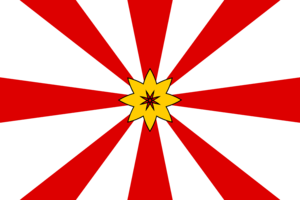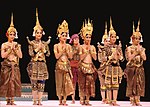Naikanghi people: Difference between revisions
mNo edit summary |
mNo edit summary |
||
| Line 44: | Line 44: | ||
| flag_caption = | | flag_caption = | ||
}} | }} | ||
The '''Naikanghi people''' ([[Naichinese languages|Naichinese]]: 乃扛人, ''Na̤îkánghí'' {{wp|international phonetic alphabet|[nɘî.kʰáŋ.hí]}} are an {{wp|Ethnicity|ethnic group}} native to [[Naikang]]. They comprise roughly 35% of Naikang's population of 21 million, though their influence, in the names of cities, aspects of early material culture, architecture and many other aspects, is felt throughout the country. They speak the [[Naichinese languages|Naichinese]] languages, a dialect continuum that has been theorised to be related to the [[Myacha language|Myacha]] languages, though this is not confirmed. The geographic spread of Naikanghi is limited, with Naikanghi only forming a majority within their [[Naikanghi Constituent State|Constituent State]] of Naikang. | The '''Naikanghi people''' ([[Naichinese languages|Naichinese]]: 乃扛人, ''Na̤îkánghí'' {{wp|international phonetic alphabet|[nɘî.kʰáŋ.hí]}}) are an {{wp|Ethnicity|ethnic group}} native to [[Naikang]]. They comprise roughly 35% of Naikang's population of 21 million, though their influence, in the names of cities, aspects of early material culture, architecture and many other aspects, is felt throughout the country. They speak the [[Naichinese languages|Naichinese]] languages, a dialect continuum that has been theorised to be related to the [[Myacha language|Myacha]] languages, though this is not confirmed. The geographic spread of Naikanghi is limited, with Naikanghi only forming a majority within their [[Naikanghi Constituent State|Constituent State]] of Naikang. | ||
The majority of Naikanghi people either follow their ancient [[Nahi folk religion|folk religions]] or follow the {{wp|Buddhism}} common to [[Chengsheng]] and the [[Beisin (region)|Beisin]] region of Naikang. There may be a minuscule Naikanghi diaspora. | The majority of Naikanghi people either follow their ancient [[Nahi folk religion|folk religions]] or follow the {{wp|Buddhism}} common to [[Chengsheng]] and the [[Beisin (region)|Beisin]] region of Naikang. There may be a minuscule Naikanghi diaspora. | ||
Revision as of 10:44, 3 October 2023
乃扛人 Na̤îkánghí | |||||
|---|---|---|---|---|---|
| Total population | |||||
| c. 7–8 million | |||||
| Regions with significant populations | |||||
| 7,640,000 | |||||
| |||||
| Languages | |||||
| Naichinese | |||||
| Religion | |||||
| Predominantly folk religions and Buddhism; minorities Christianity | |||||
The Naikanghi people (Naichinese: 乃扛人, Na̤îkánghí [nɘî.kʰáŋ.hí]) are an ethnic group native to Naikang. They comprise roughly 35% of Naikang's population of 21 million, though their influence, in the names of cities, aspects of early material culture, architecture and many other aspects, is felt throughout the country. They speak the Naichinese languages, a dialect continuum that has been theorised to be related to the Myacha languages, though this is not confirmed. The geographic spread of Naikanghi is limited, with Naikanghi only forming a majority within their Constituent State of Naikang.
The majority of Naikanghi people either follow their ancient folk religions or follow the Buddhism common to Chengsheng and the Beisin region of Naikang. There may be a minuscule Naikanghi diaspora.
Distribution
The majority of the world's Naikanghi live in Naikang, the population of which is around 35% Naikanghi.
History
Main article: History of Naikang
Origin myths
The untamed frontiers
Chengshengese settlement
Colonialism to the present
Culture and society
Main article: Culture of Naikang
Symbols

The Naikanghi produce and wear rings, though many who follow the ancient folk religion also assign particular cultural significance to the wearing of specific types of rings. Naikanghi people can often be identified by the specific rings they wear, and while the practice of assigning honourifics as a part of one's name is standard, one might be able to ascertain one's honourific by identifying the rings they wear.
Naikanghi people have specific reverence for and understanding of astronomy, and motifs such as stars are common in Naikanghi art. The Nalagqe, a specific pattern of eight rays, usually in red, emanating from a central point, is another common Naikanghi motif, often representing the unity of the Naikanghi people and nation. The display of certain types of Nalagqe is banned in certain provinces due to associations with the Naikanghi Ashang, the Naikanghi group that waged war against the State of Naikang in the Naikangese Civil War.
Attire
The Naikanghi have long been skilled at metalworking, and jewellery such as rings, bracelets, intricate chestplates and headwear have been worn as an indicator of specific Naikanghi identity. Feathered helms, often also incorporating gold or silver jewellery, are common pieces of headwear.


